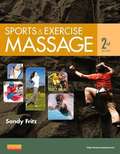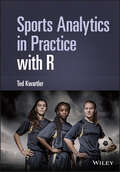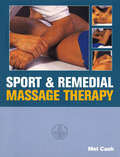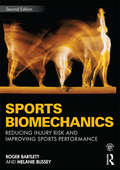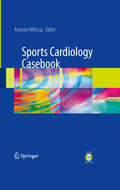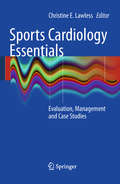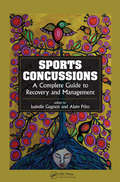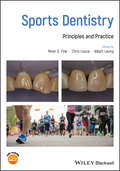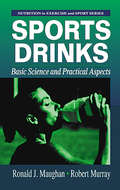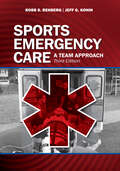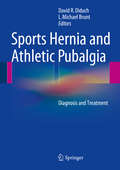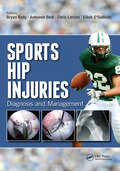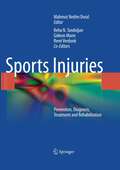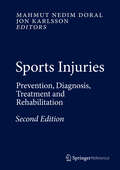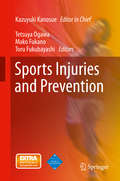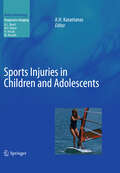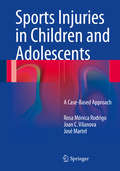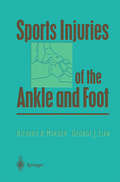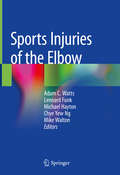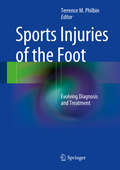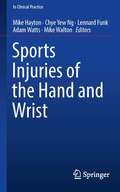- Table View
- List View
Sportphilosophie: Eine phänomenologisch fundierte Einführung
by Axel HornDie Einführung gibt einen Überblick über Inhalte und Methoden, holt den Leser mit seinen Vorverständnissen über Philosophie und Sport ab und eröffnet den Horizont für Themen, Fragen, Problemstellungen und Lösungsansätze einer Sportphilosophie.Der zweite Teil des Buches beschäftigt sich mit der Phänomenologie als einer der grundlegenden Strömungen der Philosophie des 20. Jahrhunderts. Er zeichnet Anliegen und Entwicklung der Phänomenologie anhand einiger ihrer Hauptvertreter nach und arbeitet mit „Phänomenologien der Leiblichkeit“ ein zeitgemäßes Verständnis von Körper respektive Leib heraus.Im dritten Teil geht es um eine „Phänomenologie des heutigen Sports“. Sport ist längst eine feste gesellschaftliche Größe und ein florierender wirtschaftlicher Bereich geworden. Das Buch analysiert die Verbindung des Sports zu Geld, Macht, Politik, Medien, Doping und die Rolle, die er hinsichtlich Körperkult, Spiel, Gesundheit, Bildung usw. spielt. Der Autor geht den Fragen nach, wie sich die Phänomene genauer darstellen, was sie „eigentlich“ zum Vorschein bringen, und ob der Sport tatsächlich einem Umgang mit dem Körper respektive dem Leib entspricht, wie er im philosophischen Verständnis der Leiblichkeit dargelegt wurde.
Sportpsychiatrie und -psychotherapie
by Andreas StröhleDie Sportpsychiatrie und -psychotherapie ist im deutschsprachigen Raum eine noch jüngere Spezialisierung, während Sportmedizin in Deutschland inzwischen eine fächerübergreifende ärztliche Zusatzweiterbildung darstellt. Sportpsychiatrische Kenntnisse und Expertise gewinnen jedoch sowohl im Breiten- als auch im Leistungssport zunehmend an Bedeutung, nicht zuletzt durch Erkrankungen prominenter Leistungssportler und die Diskussion ihrer Ursachen und Folgen. Auch in der Entstehung und Behandlung psychischer Erkrankungen in der Allgemeinbevölkerung kommt der Rolle von Bewegung und Sport eine immer größere Bedeutung zu. Dieses Buch bringt diese beiden Aspekte der Sportpsychiatrie und -psychotherapie zusammen. Namhafte Autoren aus der Sportmedizin, Physiologie, Psychologie, Sportpsychologie, Psychiatrie und Psychotherapie bieten zunächst einen Überblick über die Grundlagen von Sport, Bewegung und Training sowie Basiskenntnisse der Leistungs- und Sportpsychologie. Das Kernstück des Buches umfasst die Darstellung der Sport- und Bewegungstherapie bei psychischen Erkrankungen in der Allgemeinbevölkerung einerseits sowie der psychischen Erkrankungen und Besonderheiten bei (Leistungs-)Sportlern andererseits. Das Werk richtet sich an Therapeuten und Ärzte unterschiedlicher Disziplinen, insbesondere Psychiater und Sportmediziner, aber auch Psychologen und Psychotherapeuten sowie andere Berufsgruppen in Medizin, Psychiatrie und Psychotherapie, die sich für Sport und Sporttherapie interessieren. Daneben sollen aber auch Helfer und Professionelle aus dem Sport angesprochen werden, um einen Zugang zu psychischen Erkrankungen im Leistungssport zu bekommen.
Sportpsychologie: Grundlagen und Anwendung
by Henning Plessner Julia Schüler Mirko WegnerDieses Lehrbuch richtet sich an Studierende der Psychologie und Sportwissenschaft sowie an Personen, die in der Sportpraxis tätig sind und Themen der Sportpsychologie genauer und tiefgehender verstehen möchten. Zahlreiche auflockernde didaktische Elemente ermöglichen Ihnen das leichtgängige und freudvolle Lernen komplexer Sachverhalte. Im ersten Teil lernen Sie den Facettenreichtum der Sportpsychologie sowie die Untrennbarkeit von Theorie und Sportpraxis kennen. Theoretische Grundlagen sind nach den Subdisziplinen der Psychologie (Kognition, Motivation, Emotion, Persönlichkeit und soziale Prozesse) untergliedert und verständlich sowie praxisnah erläutert. Dabei werden Fragen beantwortet wie: Welche kognitiven Prozesse führen zu guten Entscheidungen in kritischen Sportspielsituationen? Wie entsteht intrinsische Motivation zum Sporttreiben? Welche Folgen hat Wettkampfangst? Trägt Sport zur Persönlichkeitsentwicklung bei? Wie hängen Teamklima und sportliche Leistung zusammen? Im zweiten Teil erfahren Sie alles Wichtige über die Anwendung der Sportpsychologie in den Kontexten Leistung und Gesundheit. Wie sehen beispielsweise theoriebasierte psychologische Trainings zur Leistungssteigerung im Spitzensport aus und wie effektiv sind diese? Besteht ein Zusammenhang zwischen Sport und Gesundheit? Die von den jeweiligen Fachexperten und -expertinnen verfassten Kapitel stellen eine umfassende und optimale Prüfungsvorbereitung dar. Zudem unterstützen die klare Struktur und Didaktik sowie die in sich abgeschlossenen Kapitel dabei, sich beim Vertiefen oder Nachlesen auf einzelne Inhaltsbereiche zu fokussieren. Das Werk ist prüfungsrelevant und regt zugleich mit wertvollen Impulsen zum Mit- und Weiterdenken an.
Sports & Exercise: Massage Comprehensive Care for Athletics, Fitness & Rehabilitation
by Sandy FritzThe second edition of this comprehensive textbook targets therapeutic massage for the sports and exercise community and responds to the specific massage needs of professional, amateur, recreational, and rehabilitative sports and exercise participants.
Sports Analytics in Practice with R
by Ted KwartlerSports Analytics in Practice with R A practical guide for those looking to employ the latest and leading analytical software in sport In the last twenty years, sports organizations have become a data-driven business. Before this, most decisions in sports were qualitatively driven by subject-matter experts. In the years since numerous teams found success with “Money Ball” analytical perspectives, the industry has sought to advance its analytical acumen to improve on- and off-field outcomes. The increasing demand for data to inform decisions for coaches, scouts, and players before and during sporting events has led to intriguing efforts to build upon this quantitative approach. As this methodology for assessing performance has matured and grown in importance, so too has the open-source R software emerged as one of the leading analytical software packages. In fact, R is a top 10 programming language that is useful in academia and industry for statistics, machine learning, and rapid prototyping. Sports Analytics in Practice with R neatly marries these two advances to teach basic analytics for sports-related use—from cricket to baseball, from basketball to tennis, from soccer to sports gambling, and more. Sports Analytics in Practice with R readers will also find: A broad perspective of sports, focusing on a wide range of sports rather than just one The first book of its kind that features coding examples Case study approach throughout the book Companion website including data sets to work through alongside the explanations Sports Analytics in Practice with R is a helpful tool for students and professionals in the sports management field, but also for sports enthusiasts who have a coding background.
Sports And Remedial Massage Therapy
by Mel CashThis is the definitive reference book on massage as a remedial therapy for sports training and sports injuries. It covers all practical and theroretical aspects of the subject, ranging from the basics through to the treatment of soft tissue injuries; and it gives guidance on how to work in a support role with medical practitioners treating more serious injury. It offers innovative new ideas like working posture and the psychology of injury treatment. This book goes beyond the conventional idea that massage is just a pleasant luxury, and shows it as a vital component in an athlete's training. The therapy offers effective pain relief for muscular problems, with practical advice on how to achieve permanant solutions to improve performance in sport.
Sports Biomechanics: Reducing Injury Risk and Improving Sports Performance
by Melanie BusseyWhen working with sports men and women, the biomechanist is faced with two apparently incompatible goals: reducing injury risk and improving sports performance. Now in a fully updated and revised edition, Sports Biomechanics introduces the fundamental principles that underpin our understanding of the biomechanics of both sports injury and performance, and explains how contemporary biomechanical science can be used to meet both of those goals simultaneously. The first four chapters of this book look closely at sports injury, including topics such as the properties of biological materials, mechanisms of injury occurrence, risk reduction, and the estimation of forces in biological structures. The last four chapters concentrate on the biomechanical enhancement of sports performance including analytical techniques, statistical and mathematical modelling of sports movements, and the use of feedback to enhance sports performance. Drawing on the very latest empirical and epidemiological data, and including clear concise summaries, self test questions and guides to further reading in every chapter, this book is essential reading for all advanced undergraduate and postgraduate students with an interest in biomechanics, sports injury, sports medicine, physical therapy or performance analysis. Visit the companion website at www.routledge.com/cw/bartlett
Sports Cardiology Casebook
by Antonio PellicciaComparatively little is known about the risk of sudden death associated with exercise in young competitive athletes, and whether the benefits of sports activity outweigh the hazards of exercise-related fatal events is a clinical dilemma. This is only a small part of the story, however, as there are considerable effects of exercise whether it be at a competitive level or on a 'leisure' level on patients of all ages. This in itself is of massive importance to the cardiac patient population as exercise is a key component of effective recovery and recommended as central in the prevention of much cardiac disease.
Sports Cardiology Essentials
by Christine E. LawlessThis book presents an invaluable symptoms-based approach to sports cardiology for sports medicine physicians, primary care physicians, and cardiologists. Edited by an authority in the field, the text offers sought-after insight on the cardiac health of athletes. Case studies are featured throughout to further understanding and the integration of concepts into daily practice. With contributions by both sports medicine physicians and cardiologists, this timely book bridges the gap between disciplines and is an unparalleled resource for those looking to effectively manage the cardiac health of active patients.
Sports Cardiology: Care of the Athletic Heart from the Clinic to the Sidelines
by David J. Engel Dermot M. PhelanProviding a critical update and review of salient topics needed for the proper cardiac evaluation and care of athletes, this text is designed to be the most up-to-date and practical manual for all health care providers who evaluate and treat athletes, including sports cardiologists, general cardiologists, sports medicine specialists, team doctors and athletic trainers. The book is divided into three key sections. The first section discusses essential topics pertaining to the pre-participation cardiac screening of athletes, providing a framework for how best to perform pre-participation cardiac evaluations and optimize the interpretation of cardiac screening test results, and a guide to assist the streamlining of appropriate downstream testing when required. The second section reviews the management and care of athletes with specific, existing cardiovascular disorders, providing the reader with fundamental principles to help recognize and advise levels of sport participation to athletes with these disorders. The final section deals with acute sideline management of the symptomatic athlete and will again provide practical algorithms for cardiologists and non-cardiologists alike who are responsible for athlete health and safety in the sports arenas and training facilities. Written and edited by highly regarded experts in the field of sports cardiology, including several cardiologists who are collegiate and professional team physicians and who work with professional sports organizations on developing policies for cardiac screening and monitoring, Sports Cardiology is an excellent practical resource for all clinicians working in the field.
Sports Concussions: A Complete Guide to Recovery and Management
by Isabelle Gagnon Alain PtitoSport-related concussions have become an increasingly important topic as evidenced by recent media attention. Due in large part to the complex nature of concussive injuries, there is great discrepancy in the effect these injuries have on individual functioning and the type and nature of services that best facilitate recovery. This book is intended as a complete reference guide dealing with sports-related concussions.
Sports Dentistry: Principles and Practice
by Peter D. Fine Chris Louca Albert LeungSports Dentistry: Principles and Practice is a comprehensive resource that addresses all aspects of this burgeoning field of dentistry. Provides a comprehensive manual that covers the fundamental principles and practice of sports dentistry Addresses all aspects of sports dentistry, including treatment of injuries, preventative measures, oral health and marketing and practice management Offers information on providing dental facilities at sporting arenas Presents suggestions for treating young children and the specific issues they present Includes a companion website with illustrative case studies
Sports Drinks: Basic Science and Practical Aspects
by Ronald J. Maughan Robert MurrayCan sports drinks improve the way you play and exercise? Athletes-both competitive and recreational-turn to the consumption of sports drinks to optimize their performance. A volume in the Nutrition in Exercise and Sports Series, Sports Drinks: Basic Science and Practical Aspects provides a review of current knowledge on issues relating to the formu
Sports Emergency Care: A Team Approach
by Jeff G. Konin Robb RehbergFor more than a decade, Sports Emergency Care: A Team Approach has filled a void in athletic training education on the subject of emergency care. Now, this updated Third Edition continues to pave the way to prepare athletic training students beyond traditional first aid training as well as providing specific information on emergency situations in sports for emergency medical services (EMS) professionals. In this updated Third Edition, Dr. Robb S. Rehberg and Dr. Jeff G. Konin, along with their 13 contributors, have created a resource that can be used in athletic training education programs as a core text in a sports emergency care course; a supplemental text in several courses that address immediate care within an athletic training education curriculum; and it can be used by EMS educators in developing continuing education programs for prehospital providers. Some of the topics included in the Third Edition: Assessment of Sports Emergencies Cardiovascular Emergencies Management of Traumatic Brain Injury Fractures and Soft Tissue Injuries Managing Mental Health Emergencies Care of Athletes with Disabilities Emergencies in Sports for the Aging Athlete Regardless of discipline, it is important for all health care providers caring for ill or injured athletes to be knowledgeable and proficient in managing sports emergencies. This ability can only be achieved through preparation and practice, and Sports Emergency Care: A Team Approach, Third Edition continues to be a groundbreaking text that gives access to the essential resources health care providers need to address sports emergencies. This includes but is not limited to athletic trainers, emergency medical technicians and paramedics, and physicians.From the Foreword: “Emergencies can occur anytime and anywhere in sports, including at a practice or on the bus traveling to an event. After nearly 40 years as a professional sports athletic trainer, these emergency moments give me pause. Preparation is the key to successful outcomes in all emergencies.” —Ronnie P. Barnes, MS, ATC Senior Vice President, Medical Services Head Athletic Trainer New York Football Giants
Sports Hernia and Athletic Pubalgia
by David R. Diduch L. Michael BruntSports hernias are an increasingly recognized problem in athletics, presenting a challenge for team physicians and other health care providers regarding their diagnosis and management. Confusion is magnified by the various treatment methods that exist, both surgical and non-surgical. Sports Hernia and Athletic Pubalgia is the first text devoted solely to the topic of sports hernia and will examine its etiology and diagnosis, as well as how to differentiate it from other problems involving the athlete's hip area and other injuries it often correlates and interacts with, such as femoroacetabular impingement. It covers all current approaches to treatment, from open approaches to minimally invasive approaches, and discusses rehabilitation and return to play. Comprised of contributions from an international array of expert clinicians and thought leaders, this is the immediate authoritative book on the subject of sports hernias.
Sports Hip Injuries: Diagnosis and Management
by Bryan Kelly Asheesh Bedi Chris Larson Eilish O'SullivanIn the world of sports, hip injuries among an athletic population can be very difficult to diagnose and manage. That’s why Sports Hip Injuries: Diagnosis and Management is a comprehensive guide to diagnosing and managing sports hip injuries and hip preservation. Drs. Bryan Kelly, Asheesh Bedi, Chris Larson, and Eilish O’Sullivan are leaders in the field of hip preservation. They present Sports Hip Injuries: Diagnosis and Management in a concise manner by focusing on hip and pelvis disorders and cover all of the typical disorders seen in athletes presenting with hip and pelvic pain. The anatomy, presentation, clinical evaluation, imaging, nonsurgical and surgical treatment, and post-surgical rehabilitation of hip joint disorders are presented clearly throughout.Some of the topics Include: Femoroacetabular impingement Hip instability/dysplasia Athletic pubalgia/core muscle injury Stress fractures and traumatic sports injuries of the hip and pelvis Myotendinous injuries and nerve entrapment disorders of the hip and pelvis Rehabilitation guidelines and return to sport outcomes Sports Hip Injuries: Diagnosis and Management is an invaluable resource for sports medicine providers including orthopedic surgeons and fellows that care for patients presenting with hip pain for athletes at all levels, as well as physical therapists and athletic trainers.
Sports Injuries
by René Verdonk Gideon Mann Mahmut Nedim Doral Reha N. TandoğanIn recent years, research studies into sports injuries have provided healthcare professionals with a better understanding of their etiology and natural history. On this basis, novel concepts in the diagnosis and management of these conditions are now being explored. This timely book offers a complete guide to the latest knowledge on the diagnosis and treatment of the full range of possible sports injuries. Individual sections are devoted to biomechanics, injury prevention, and the still emerging treatment role of growth factors, which foster more rapid tissue healing. Sports injuries of each body region are then examined in detail, with special attention to diagnostic issues and the most modern treatment techniques. In addition, pediatric sports injuries, extreme sports injuries, the role of physiotherapy, and future developments are extensively discussed. All who are involved in the care of patients with sports injuries will find this textbook to be an invaluable, comprehensive, and up-to-date reference.
Sports Injuries
by Mahmut Nedim Doral Jon KarlssonSports Injuries: Prevention, Diagnosis, Treatment and Rehabilitation covers the whole field of sports injuries and is an up-to-date guide for the diagnosis and treatment of the full range of sports injuries. The work pays detailed attention to biomechanics and injury prevention, examines the emerging treatment role of current strategies and evaluates sports injuries of each part of musculoskeletal system. In addition, pediatric sports injuries, extreme sports injuries, the role of physiotherapy, and future developments are extensively discussed. All those who are involved in the care of patients with sports injuries will find this textbook to be an invaluable, comprehensive, and up-to-date reference.
Sports Injuries and Prevention
by Kazuyuki Kanosue Tetsuya Ogawa Mako Fukano Toru FukubayashiThis book presents the incidence of sports-related injuries, the types of injuries specific to particular sports, and the importance of factors such as age and gender. Possible injury mechanisms and risk factors are presented based on an analysis involving recent scientific findings. A variety of sports are included to allow the reader to better generalize the results as well as to apply appropriate procedures to specific sports. The authors have emphasized basic scientific findings to help the reader gain a broad knowledge of sports injuries. The potential audience includes medical doctors, physical therapists, athletic trainers, coaches and interested parents. This book is expected to play a prominent role in the construction of training programs for both healthy and injured players. The focus on junior athletes will aid in their education, injury prevention and increased performance. It will also benefit instructors at the junior and senior high school levels. The book is composed of seven parts. In the beginning part, current situations and the general characteristics of sports-related injuries are outlined on the basis of an investigation utilizing statistical data involving a large number of populations. In the following parts, detailed information on the injuries in terms of the types of sports activities, body sites, symptoms and the relationships among these factors are discussed. Part 2, for example, deals with topics on concussion and severe head-neck injuries which occur frequently in rugby and judo. In Parts 3 and 4, as one of the major sports-related injuries, anterior cruciate ligament (ACL) injuries are discussed. Beginning with the underlying mechanisms as assessed by using the latest measuring techniques, characteristic features of their occurrence are described. Further, Part 4 deals with topics on post-operative (ACL reconstruction) aspects of ACL injuries, especially those related to muscle functions and tendon regeneration in the hamstring muscles. Part 5 deals with muscle strain and focuses particularly on those occurring in the hamstring muscles, as this muscle group is known, as one of the most frequent sites of muscle strain. In Part 6, disorders related to the ankle and foot are introduced. Finally, Part 7 provides information on lower back disorders. Included are detailed mechanisms of their incidence, epidemiology and implications for their prevention.
Sports Injuries in Children and Adolescents
by Apostolos H. KarantanasThe incidence of acute and overuse sports injuries in children and adolescents are increasing. Radiologists need to be familiar with the advantages and limitations of the various imaging modalities used to evaluate the injured young athlete. This book, written by leading experts from Europe and the United States, covers a wide spectrum of sports injuries seen in children and adolescents. The first part comprises a series of introductory chapters on topics such as the clinician's viewpoint, normal anatomy and variants, the imaging of articular cartilage, and the current role of ultrasonography. In subsequent chapters, each important site of injury is considered individually with the aid of informative images. The final part of the book resembles an atlas and presents the most commonly encountered injuries in the popular sports of football, skiing, water sports, tennis, and gymnastics. Throughout, particular attention is paid to the most recent advances in knowledge and imaging.
Sports Injuries in Children and Adolescents
by Joan C. Vilanova Rosa Mónica Rodrigo José MartelThis introduction to sports injuries in children and adolescents is written in a user-friendly format and takes into account the fact that sports injuries in the pediatric population are not an easy topic for non-pediatric orthopedic surgeons, pediatricians, and non-pediatric radiologists. The book is divided into five chapters on musculoskeletal particularities in children, head and spine trauma, muscle strains and avulsion injuries, bone fractures, overuse injuries, and miscellanea. Each of these chapters comprises ten cases, and each case study includes up to four figures, a description of the clinical case, a review of the pathophysiology of the condition described in the case, and a final section on imaging findings. Sports Injuries in Children and Adolescents is a case-based book aimed at pediatricians, pediatric orthopedic surgeons, and radiologists.
Sports Injuries of the Ankle and Foot
by Richard A. Marder George J. LianAs more internists and family physicians increase their scope to include sports medicine, this book reaches beyond the orthopaedic surgery market to provide a one-source reference for the treatment of both simple and complex sports-related injuries. For ease of use, the book is divided into the various anatomical sections: the forefoot, the midfoot, the hindfoot, the ankle, tendon disorders, and orthotics and braces - each enhanced by rehabilitation procedures and algorithms. It enables the physician to formulate a treatment plan and compare the various surgical and non-surgical options for a variety of injuries including: stress and other fractures, ankle instability, ruptures, sprain, ligament injuries, tendonitis, lesions, and neuropathies. The text is supported by copious illustrations, including 100 line drawings, 99 operative photos and a full-colour 4-page insert.
Sports Injuries of the Elbow
by Lennard Funk Chye Yew Ng Mike Walton Michael Hayton Adam C. WattsThis book provides a concise guide to the diagnosis, investigations, surgical principles and post-operative rehabilitation to sports injuries of the elbow. It features guidance on best practice and information on the appropriate use of the latest diagnostic and therapeutic techniques. Injuries seen in athletes who participate in overhead and contact sports are discussed along with a range of other injury types. Relevant concepts in applied biomechanics and information on sport-specific rehabilitation are also covered enabling the reader to develop a deep understanding of how to develop appropriate treatment plans tailored to individual needs. Sports Injuries of the Elbow comprehensively covers the diagnosis and treatment of patients with elbow injuries acquired during sporting activities, and is an indispensable resource for all medical professionals seeking an up-to-date reference on how to diagnose and treat a range of sports injuries that affect the elbow.
Sports Injuries of the Foot
by Terrence M. PhilbinSports Injuries of the Foot is the go-to text for the management and treatment of foot injuries in athletes, demonstrating the current state-of-the-art techniques in assessment, testing and treatment. Organized anatomically beginning with the toes and working down the foot, it covers such common athletic injuries as turf toe, bunions, MTP instability and mid foot and navicular fractures, all in the context of athletic activity. Attention is also given to special considerations for the adolescent and female athlete, with an eye toward return to play. Written by clinicians for clinicians, it will be an invaluable resource for orthopedists, podiatrists, team physicians, athletic trainers and primary care providers alike.
Sports Injuries of the Hand and Wrist (In Clinical Practice)
by Lennard Funk Mike Hayton Chye Yew Ng Adam Watts Mike WaltonThis book provides insights into sports medicine addressing trauma of the hand and wrist. This collection of injuries invites readers to trace aetiology, diagnosis, relevant pathology, management principles, and outcomes of numerous injuries in elite and non-elite athletes. The authors present management principles and outcomes. It is an ideal reference for postgraduate musculoskeletal doctors and therapists for Orthopaedic and Sports Medicine postgraduate degrees. Each approach to deal with an injury is underlined by case reports. Readers will also find valuable questions and answers fro self-assessment purpose. Sports Injuries of the Hand and Wrist is aimed at sports doctors, musculoskeletal doctors, senior orthopedic trainees with an interest in upper limb, orthopedic trainees preparing for the FRCSOrth exam and similar international exams, as well as upper hand and wrist surgeons in the earlier years of their practice.



